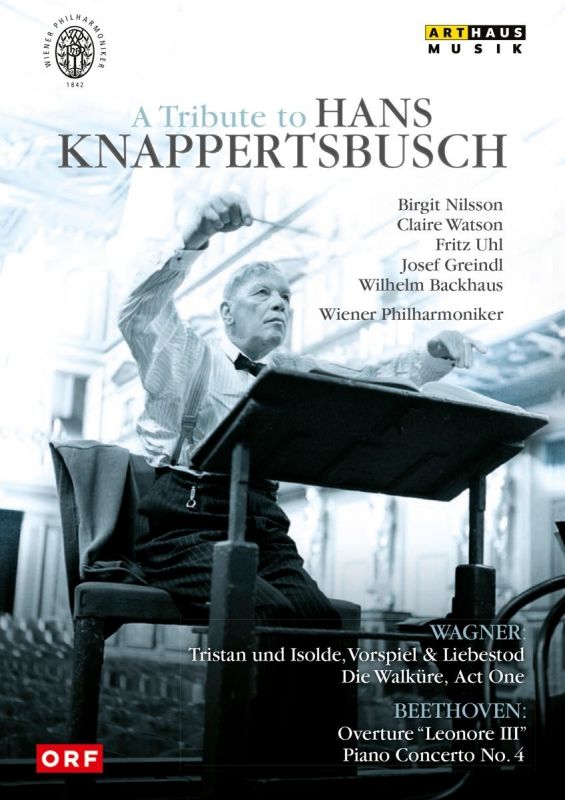A Tribute to Hans Knappertsbusch
View record and artist detailsRecord and Artist Details
Composer or Director: Ludwig van Beethoven, Richard Wagner
Genre:
Opera
Label: Arthaus Musik
Magazine Review Date: 06/2016
Media Format: Digital Versatile Disc
Media Runtime: 152
Mastering:
DDD
Catalogue Number: 109 212

Tracks:
| Composition | Artist Credit |
|---|---|
| Tristan und Isolde, Movement: Prelude |
Richard Wagner, Composer
Hans Knappertsbusch, Conductor Richard Wagner, Composer Vienna Philharmonic Orchestra |
| Tristan und Isolde, Movement: Mild und leise (Liebestod) |
Richard Wagner, Composer
Birgit Nilsson, Isolde, Soprano Hans Knappertsbusch, Conductor Richard Wagner, Composer Vienna Philharmonic Orchestra |
| (Der) Ring des Nibelungen: Part 2, '(Die) Walküre', Movement: Act 1 |
Richard Wagner, Composer
Claire Watson, Sieglinde, Soprano Fritz Uhl, Siegmund, Tenor Hans Knappertsbusch, Conductor Josef Greindl, Hunding, Bass Richard Wagner, Composer Vienna Philharmonic Orchestra |
| Leonore |
Ludwig van Beethoven, Composer
Hans Knappertsbusch, Conductor Ludwig van Beethoven, Composer Vienna Philharmonic Orchestra |
| Concerto for Piano and Orchestra No. 4 |
Ludwig van Beethoven, Composer
Hans Knappertsbusch, Conductor Ludwig van Beethoven, Composer Vienna Philharmonic Orchestra Wilhelm Backhaus |
Author: Mike Ashman
Nonetheless, I agree with Alan Blyth (writing in 2004) that these historic performances remain more golden than their ageing picture frames. For me this Leonore No 3 is neither ‘pawky’ nor ‘undramatic’ (as Blyth felt), rather a representative example of Knappertsbusch in the classics – ‘slow’ by the clock but free of the Rossini-like crescendo-ing introduced by some conductors performing it as an entr’acte during Act 2 of Fidelio. In the Concerto, enjoy the careful balancing of dynamics as Orpheus tames the Furies and the (surprisingly) light steering of the finale. The 78-year-old Backhaus’s right hand lacks its touch of yesteryear which, combined with ‘period’ piano sound, can make for some uncomfortably trebly listening. The Tristan Prelude, characteristically shorn of Romantic over-anticipation, has a powerful climax magicked out of apparently nowhere while Nilsson, and ORF’s balance engineers, take the greatest of care with her text.
The first half of Die Walküre Act 1 suits Knappertsbusch’s grave spaciousness, a kind of blacker lower-life Tristan. But as soon as Josef Greindl’s frightening Hunding has finished, grave spaciousness begins to feel like unexcited lethargy. Klemperer (Testament) may be slower and heavier but is everywhere sensual and more dramatic. Claire Watson – an admirable Marschallin and Ellen Orford – is backwards in coming forwards at conveying erotic emotion on the concert platform: there’s little mystery in her uncovering of Siegmund’s identity. Nor does Knappertsbusch allow his Wälsungs a real climax either at the peak of Sieglinde’s ‘Der Männer Sippe’ or when Siegmund (an effective and more passionate Fritz Uhl) draws out the sword – although he puts a deal of ensemble-threatening energy into not getting faster as the act ends.
Overall, a reissue lily in need of more gilding.
Discover the world's largest classical music catalogue with Presto Music.

Gramophone Digital Club
- Digital Edition
- Digital Archive
- Reviews Database
- Full website access
From £8.75 / month
Subscribe
Gramophone Full Club
- Print Edition
- Digital Edition
- Digital Archive
- Reviews Database
- Full website access
From £11.00 / month
Subscribe
If you are a library, university or other organisation that would be interested in an institutional subscription to Gramophone please click here for further information.




